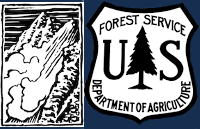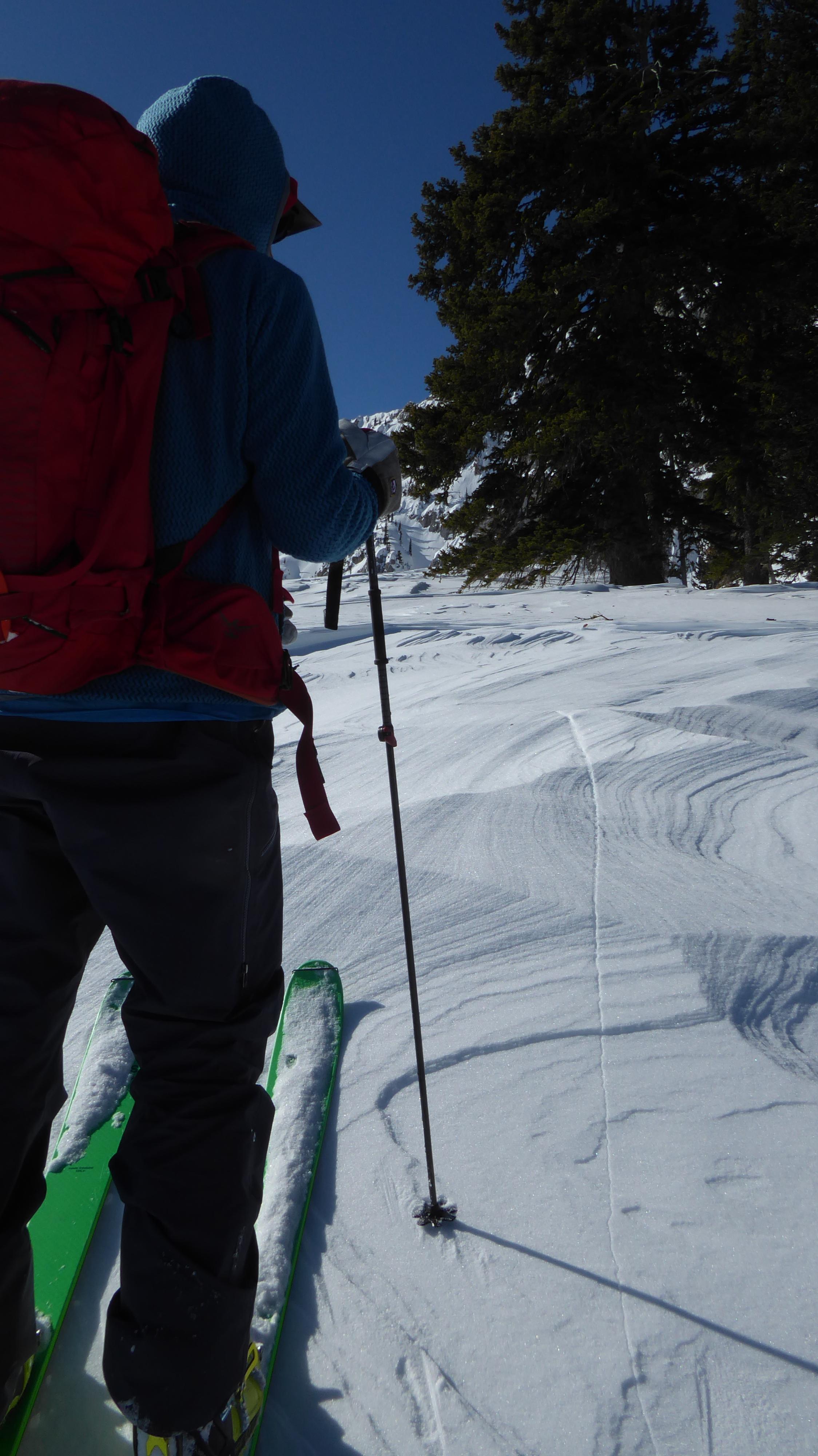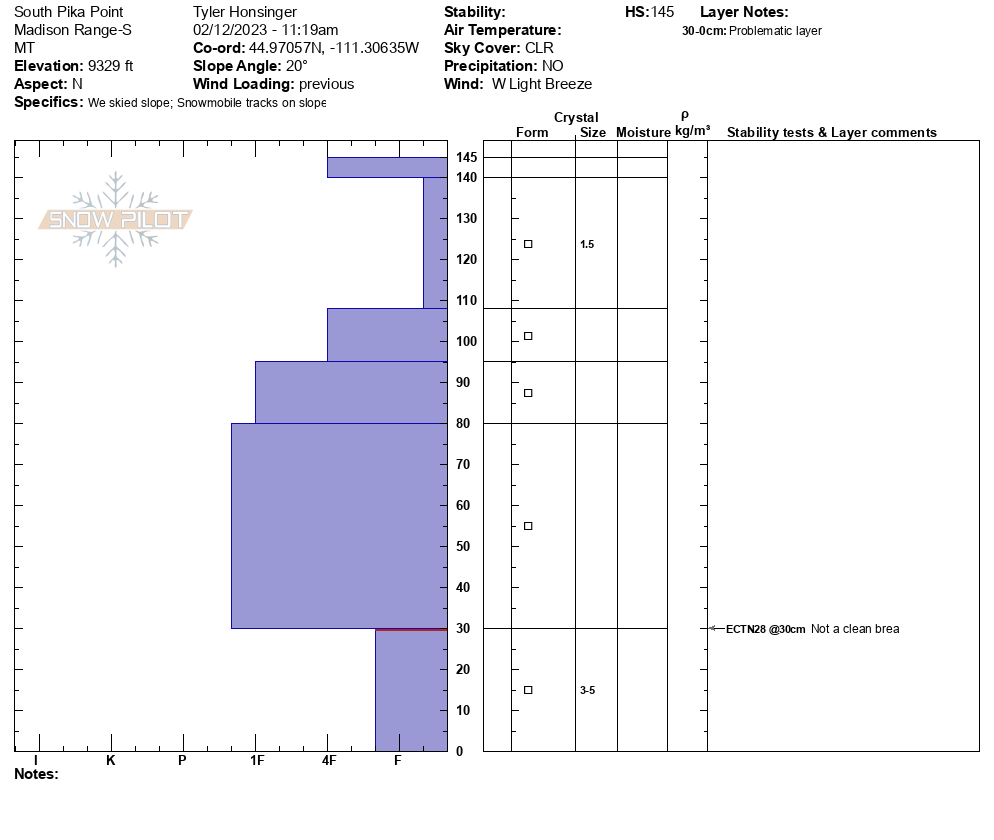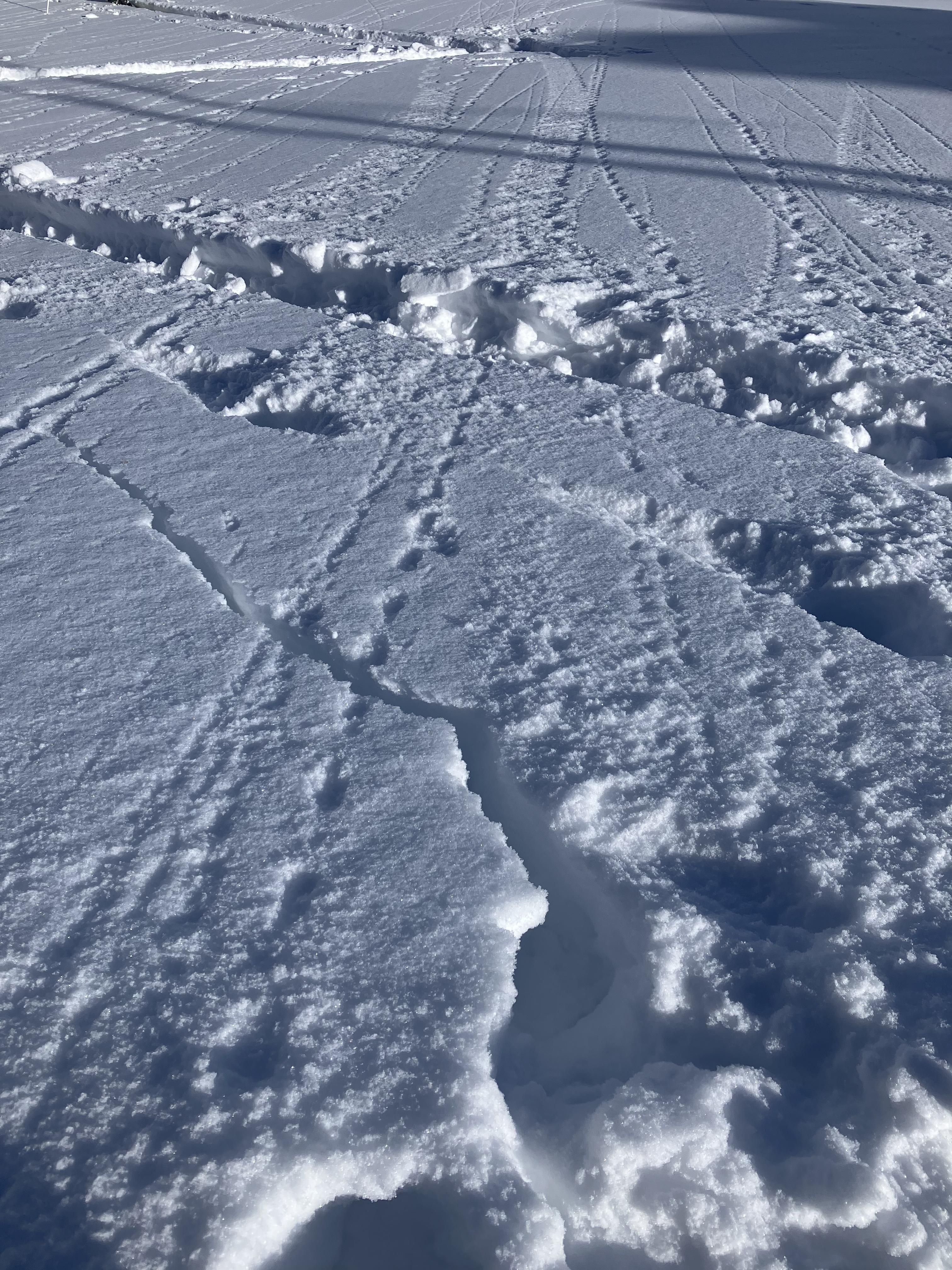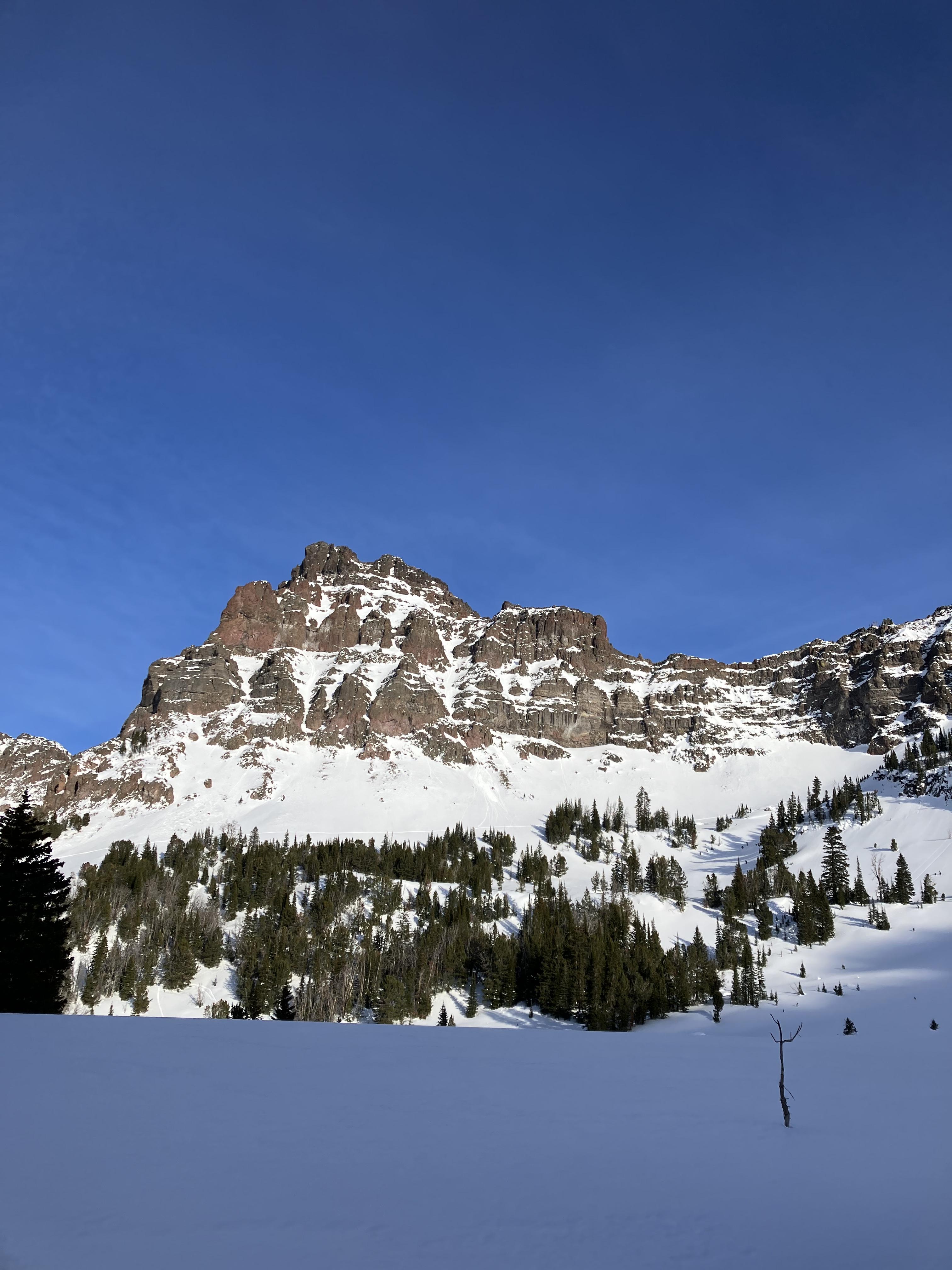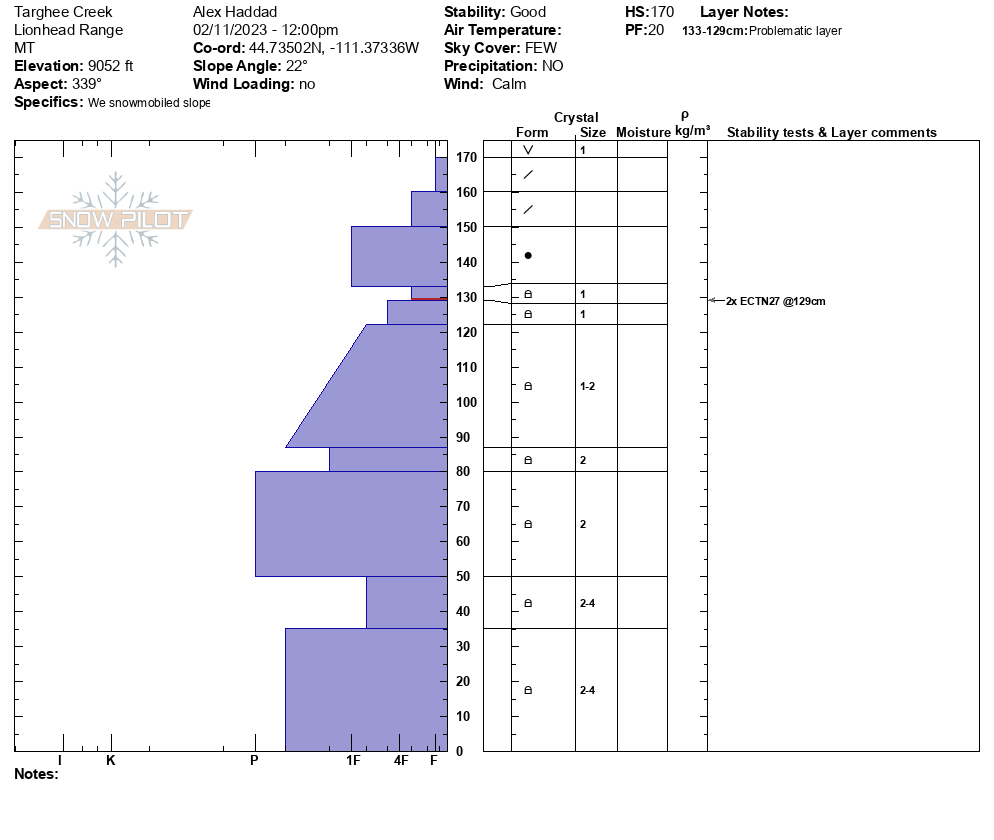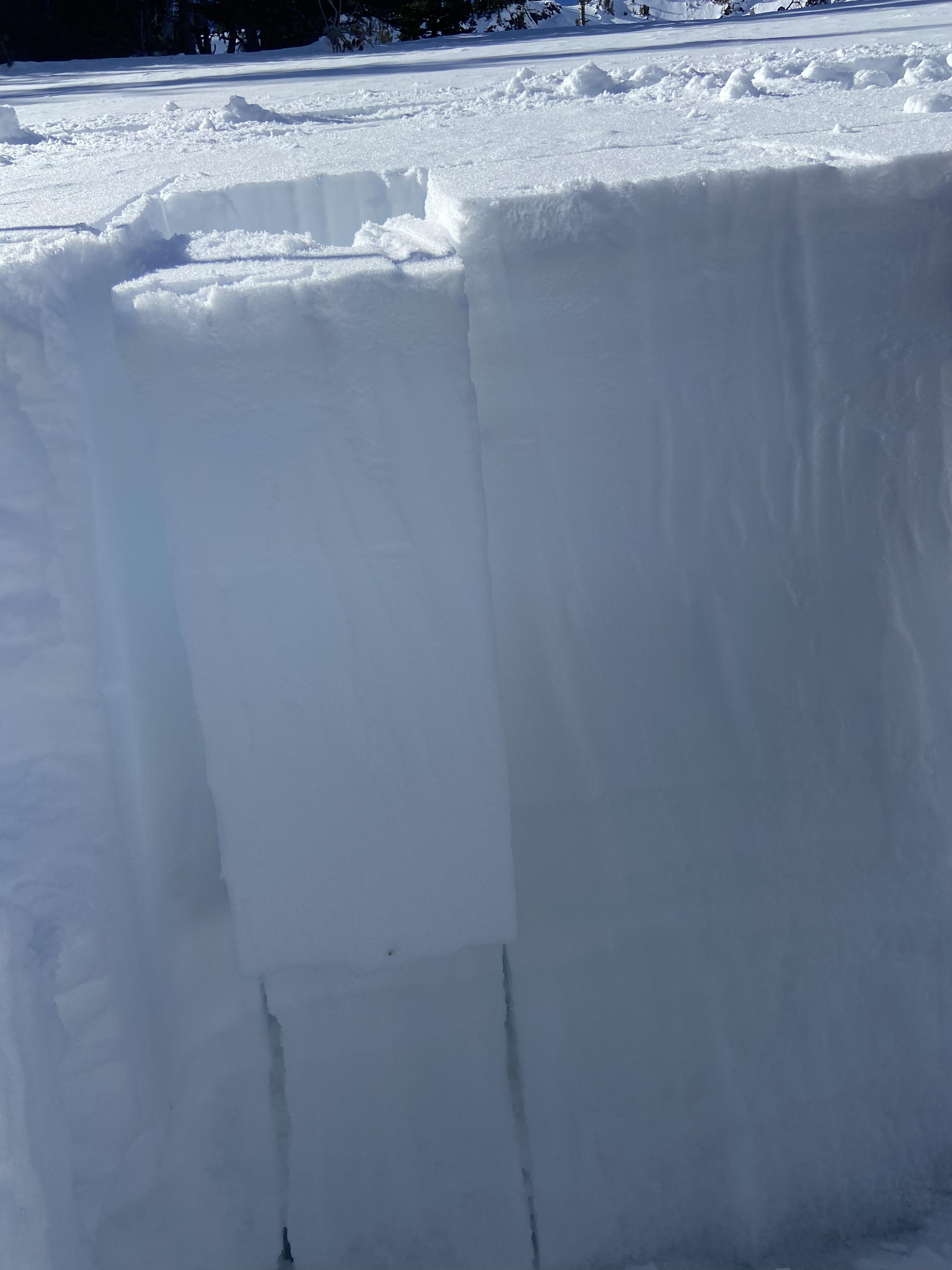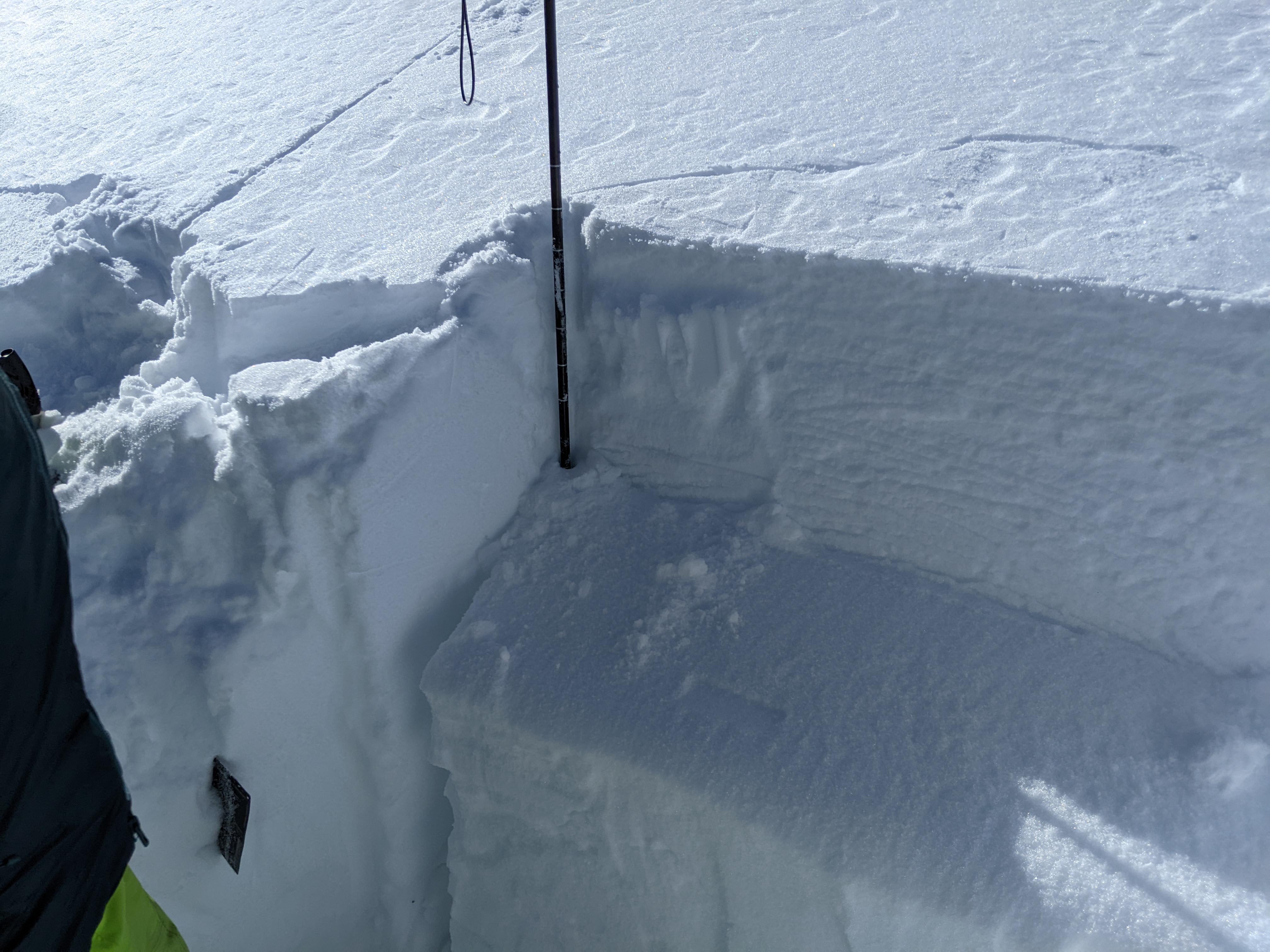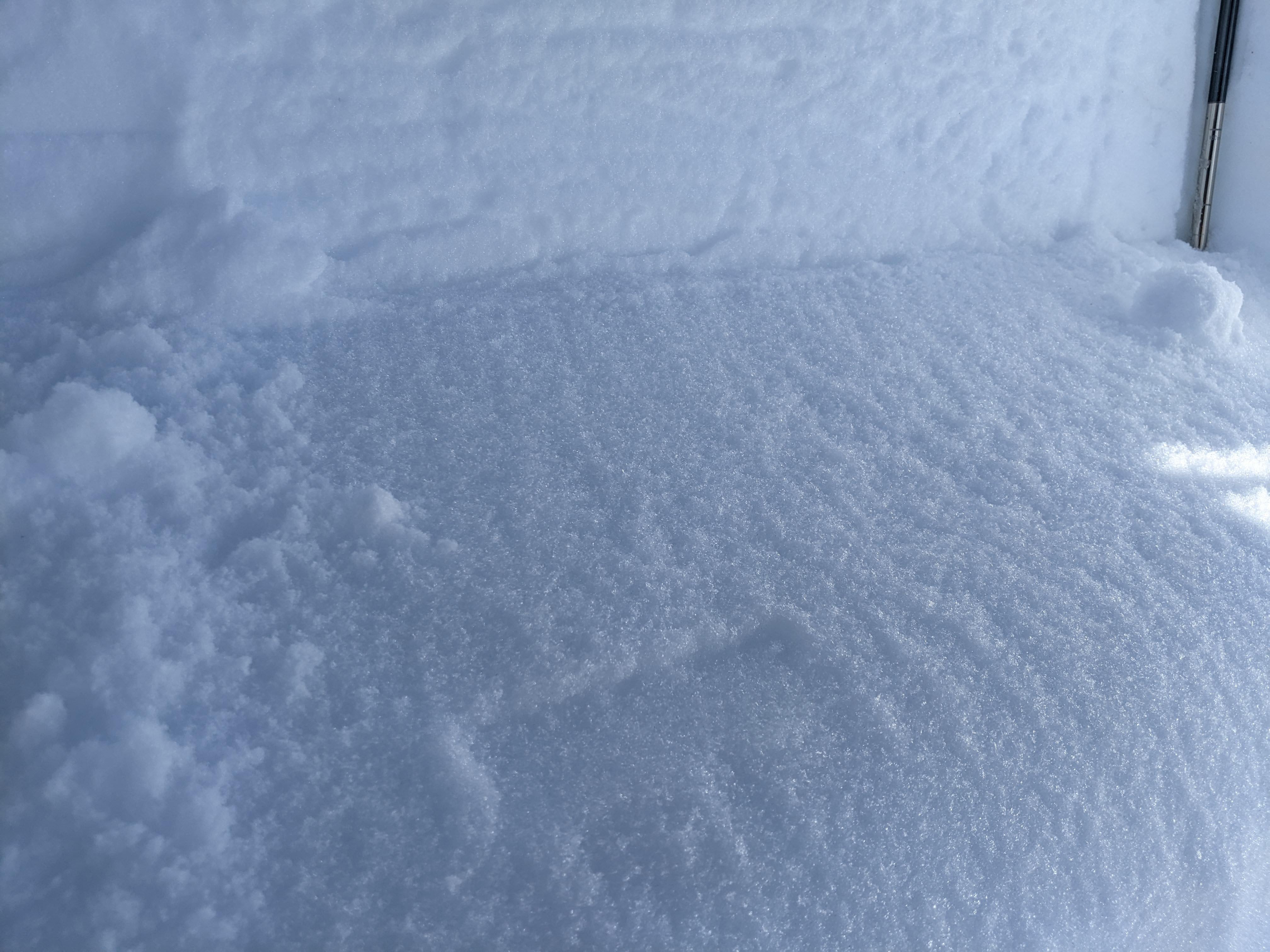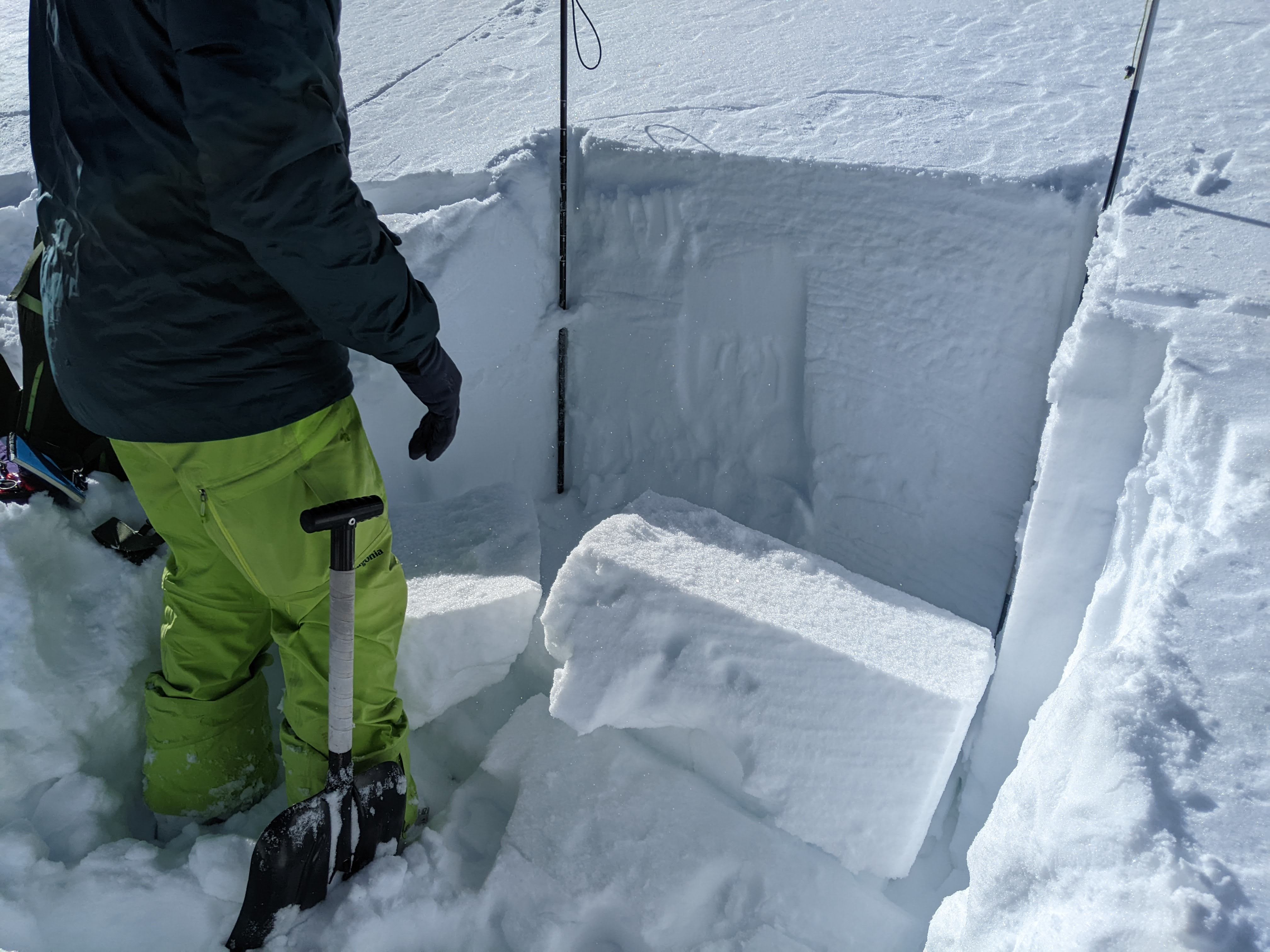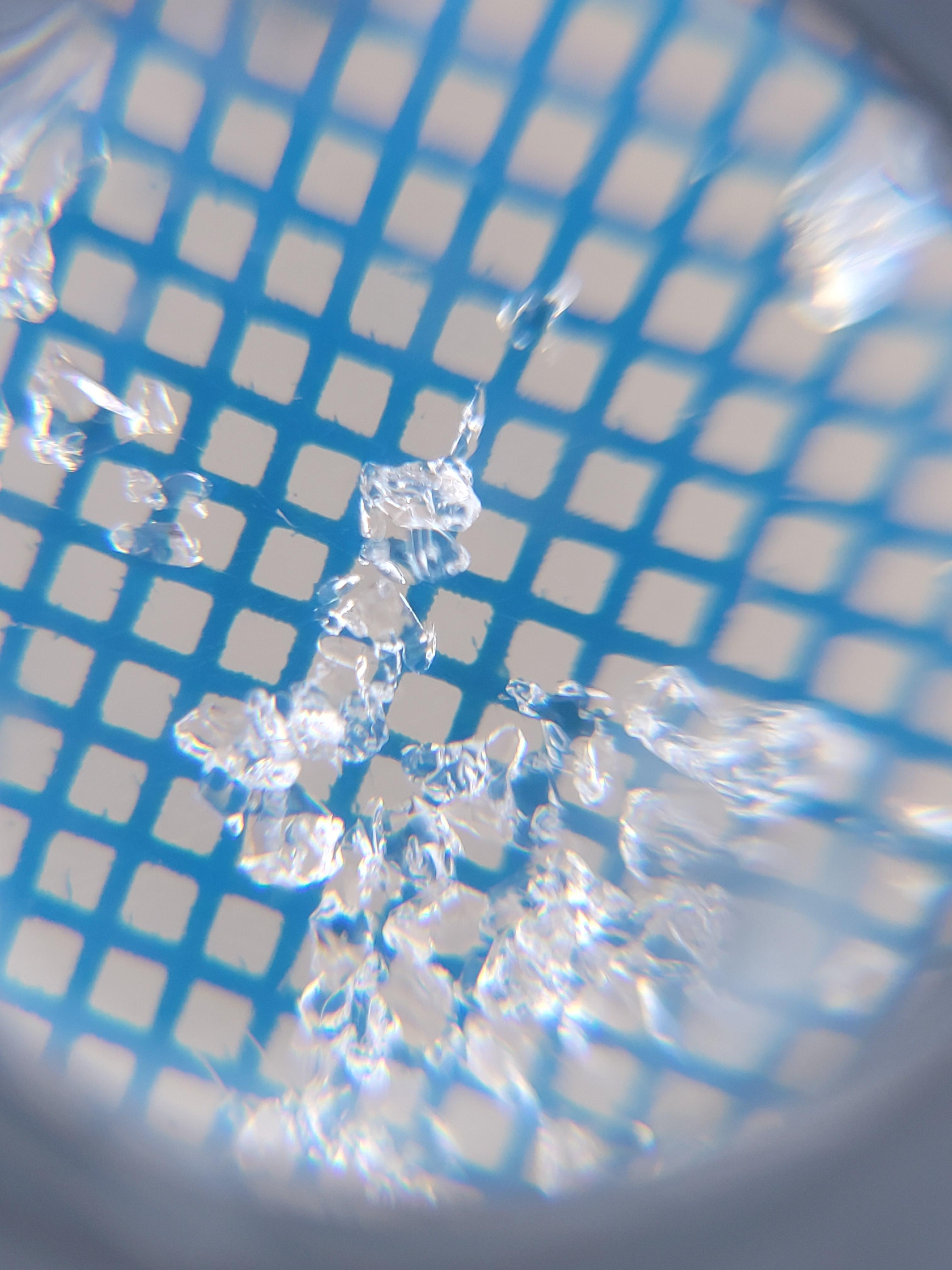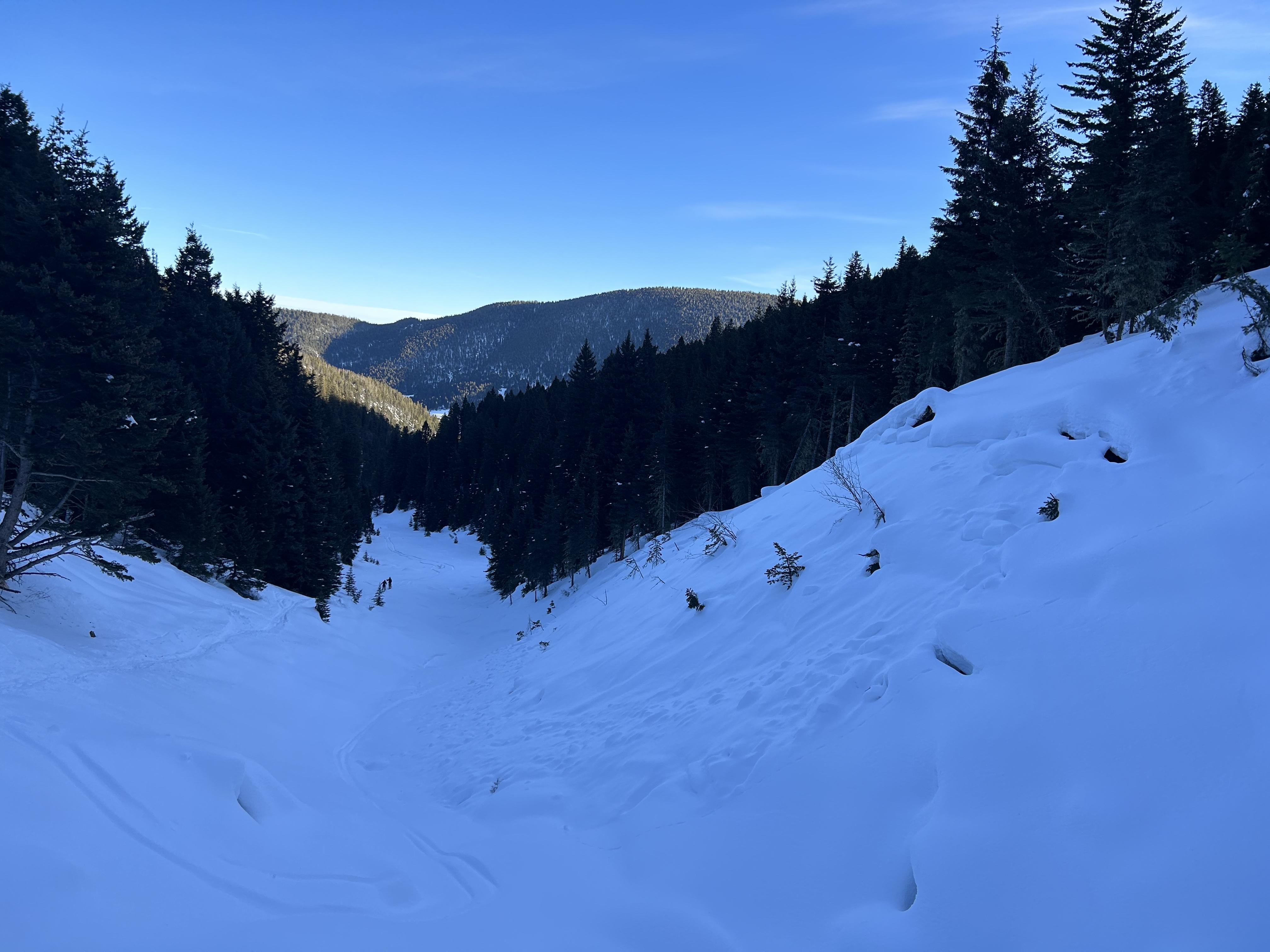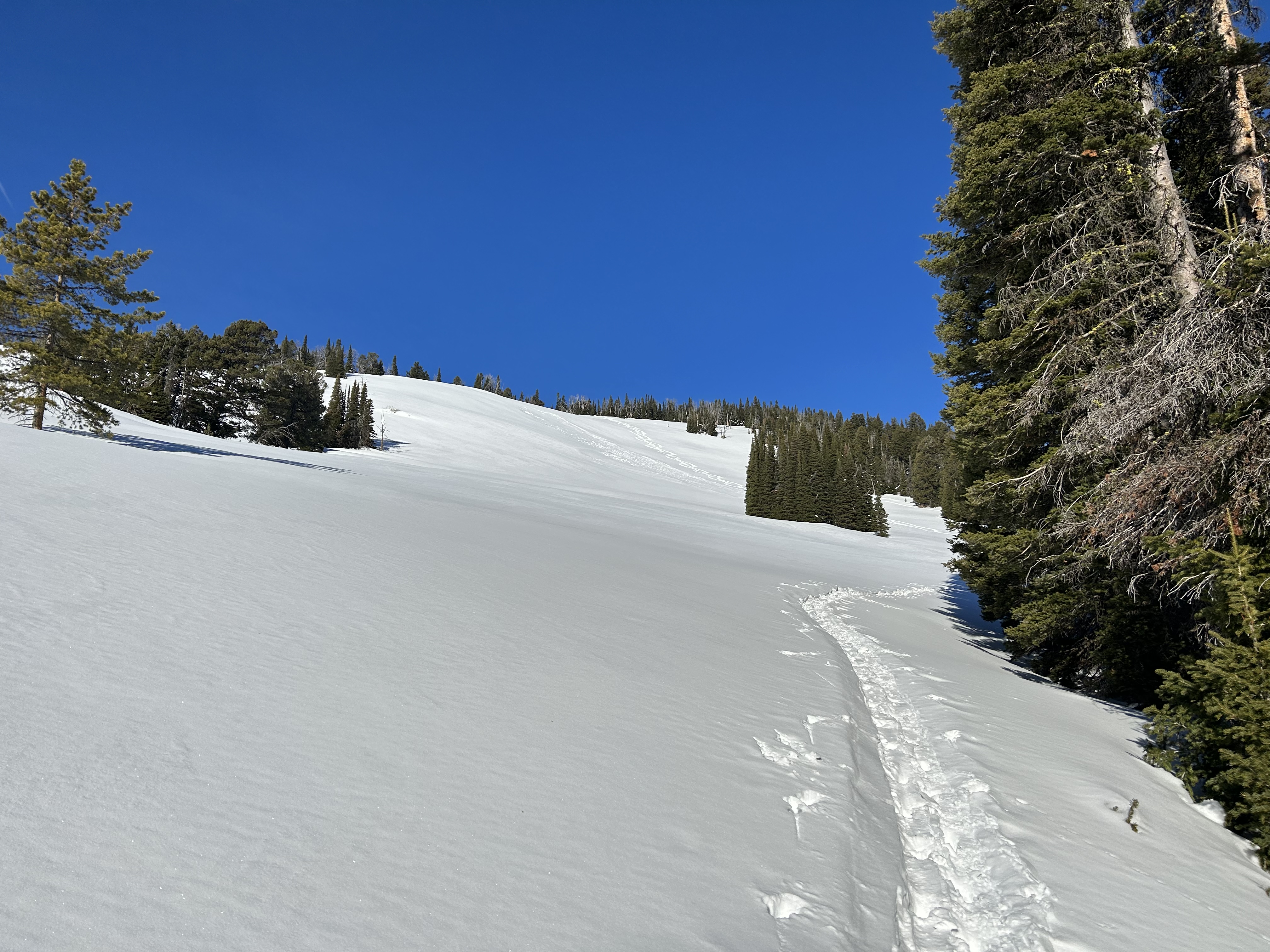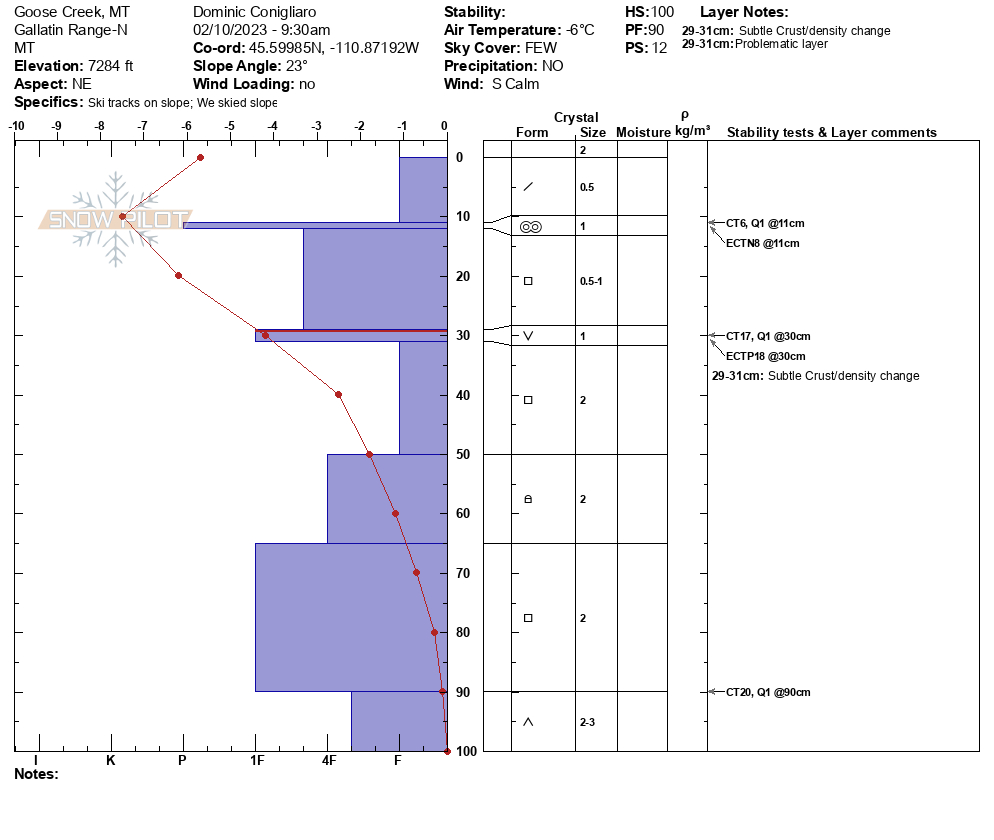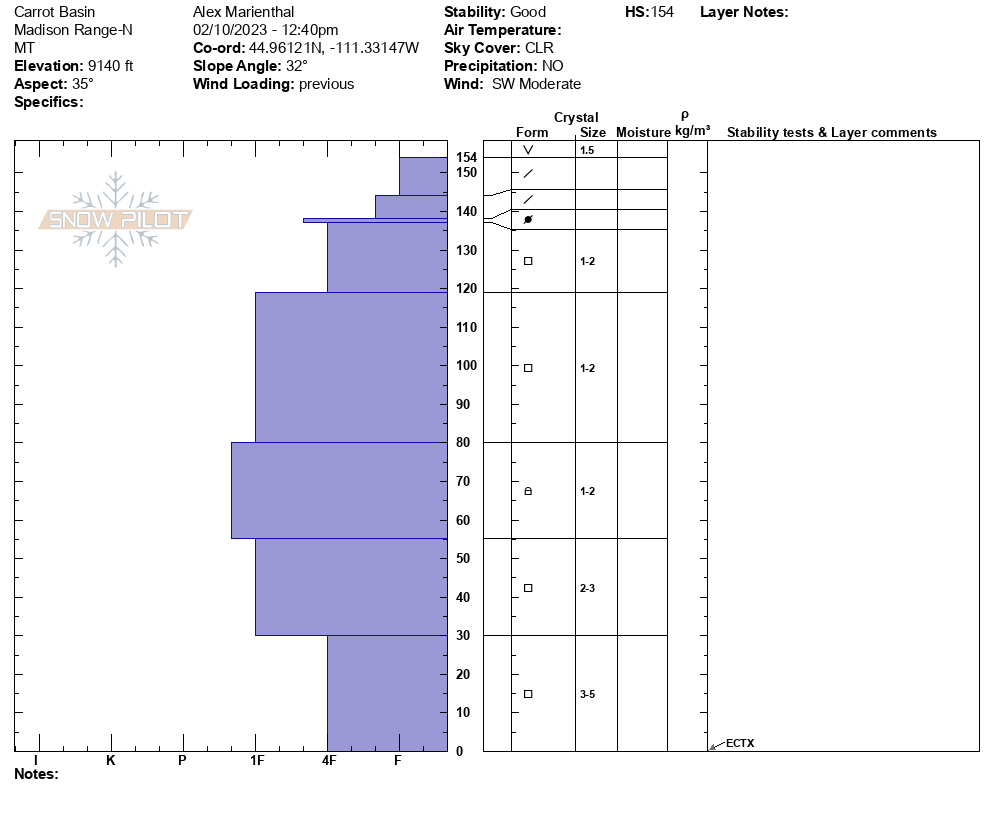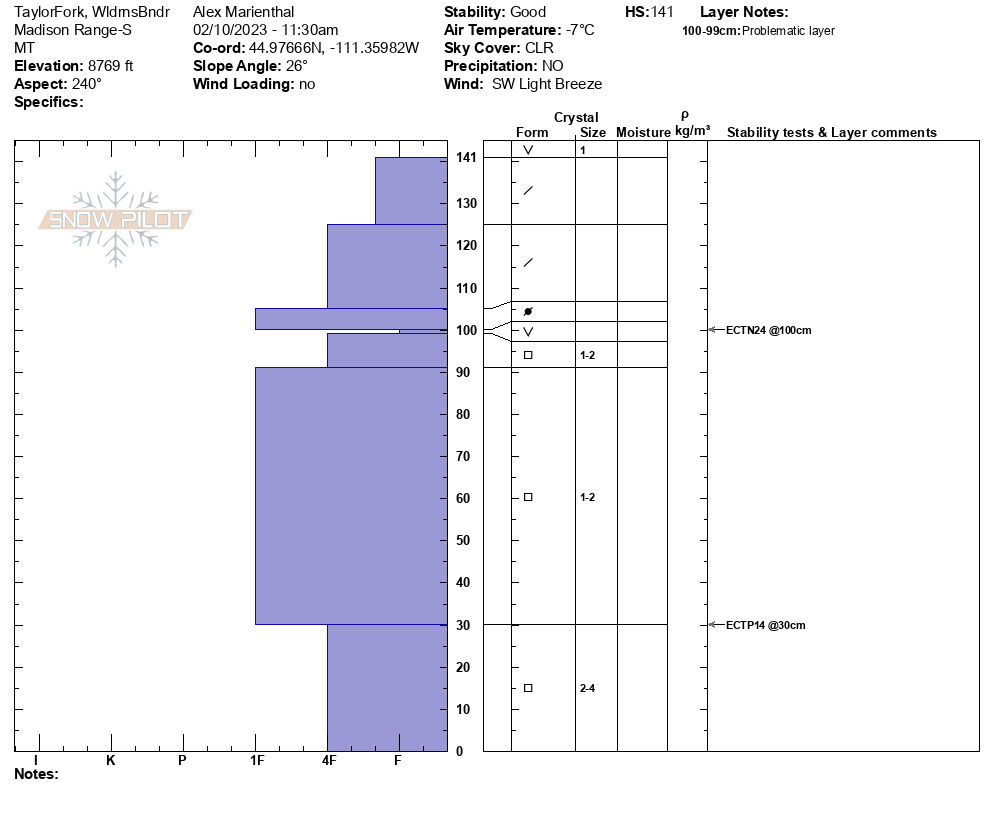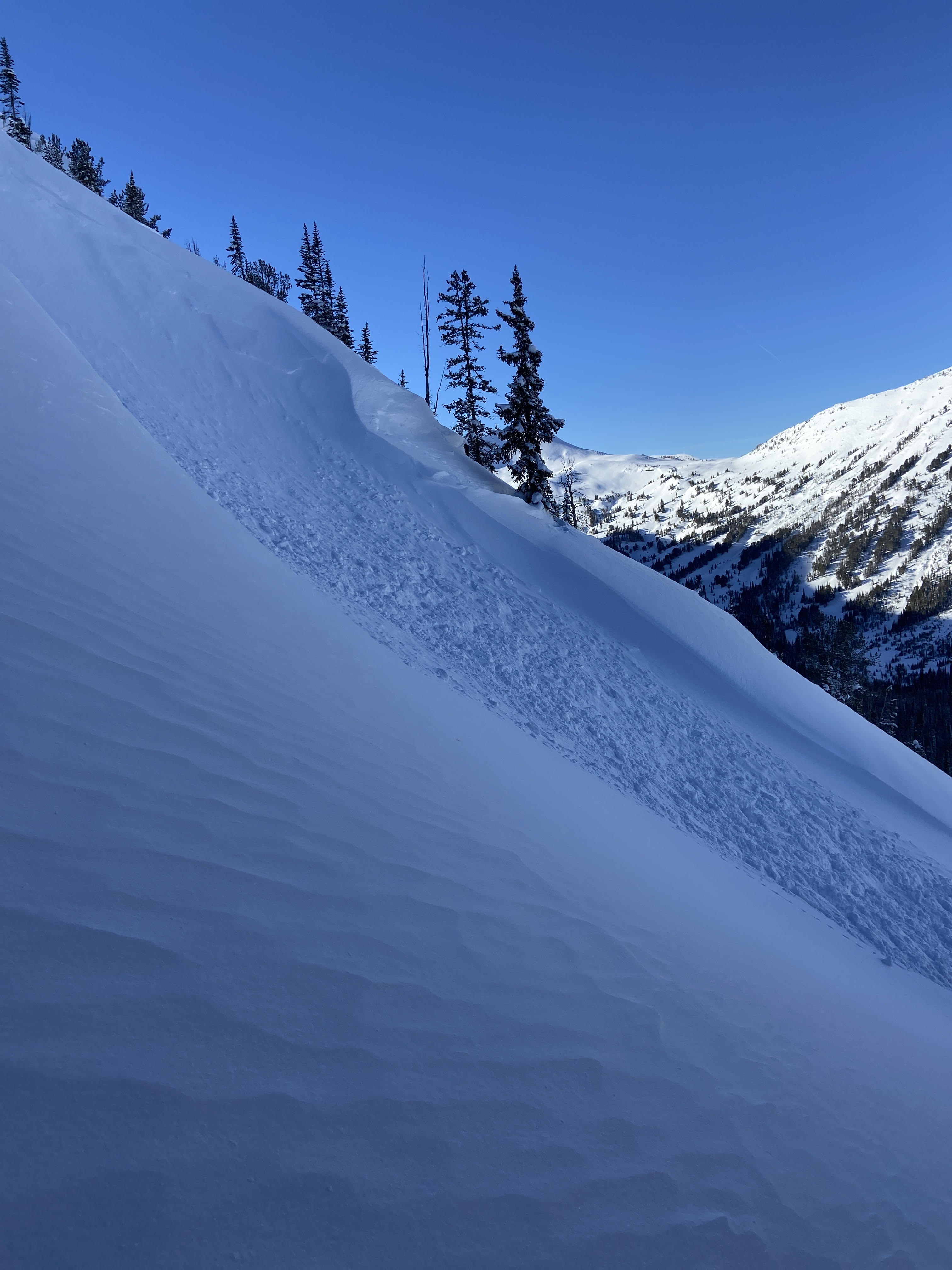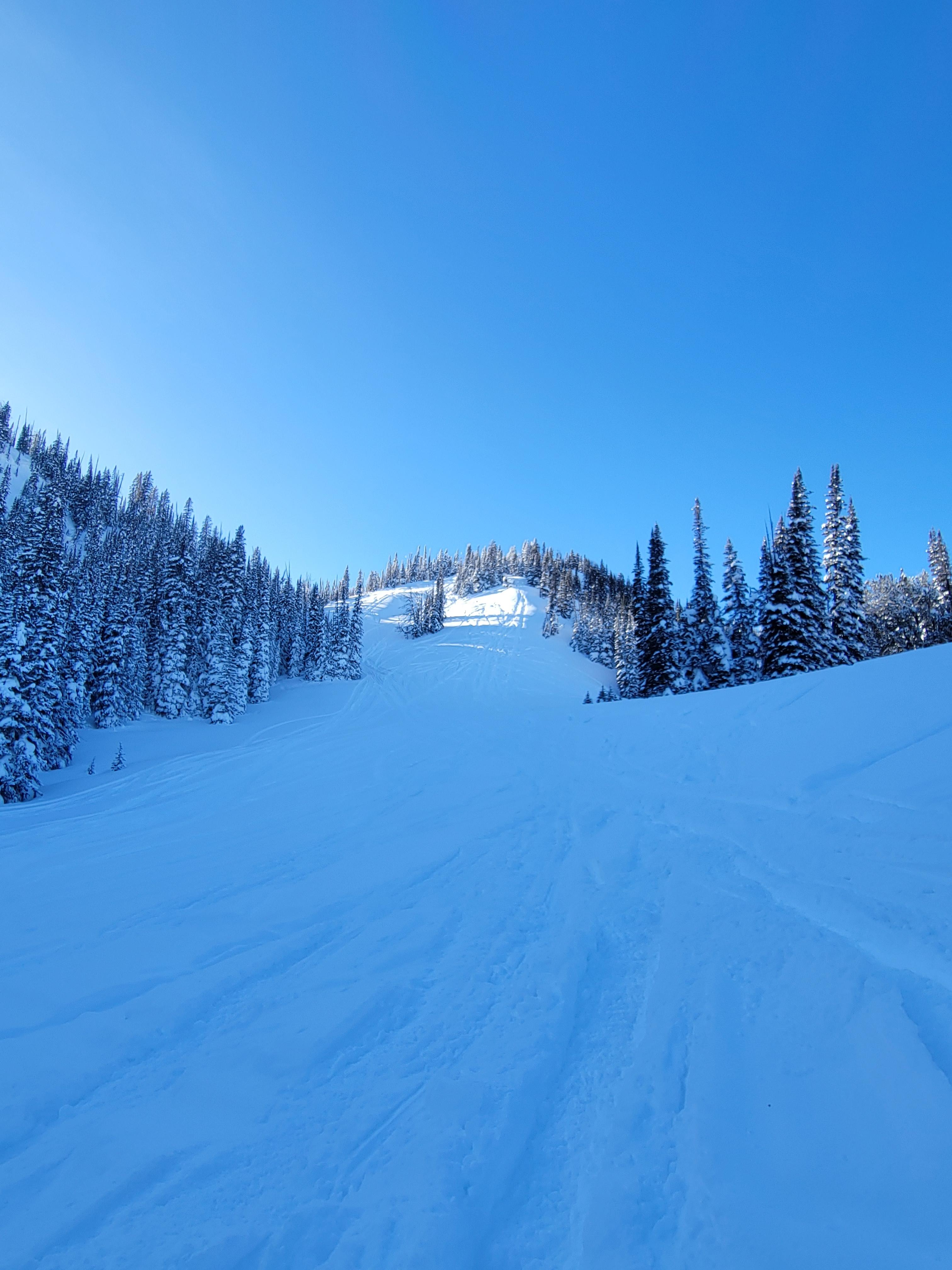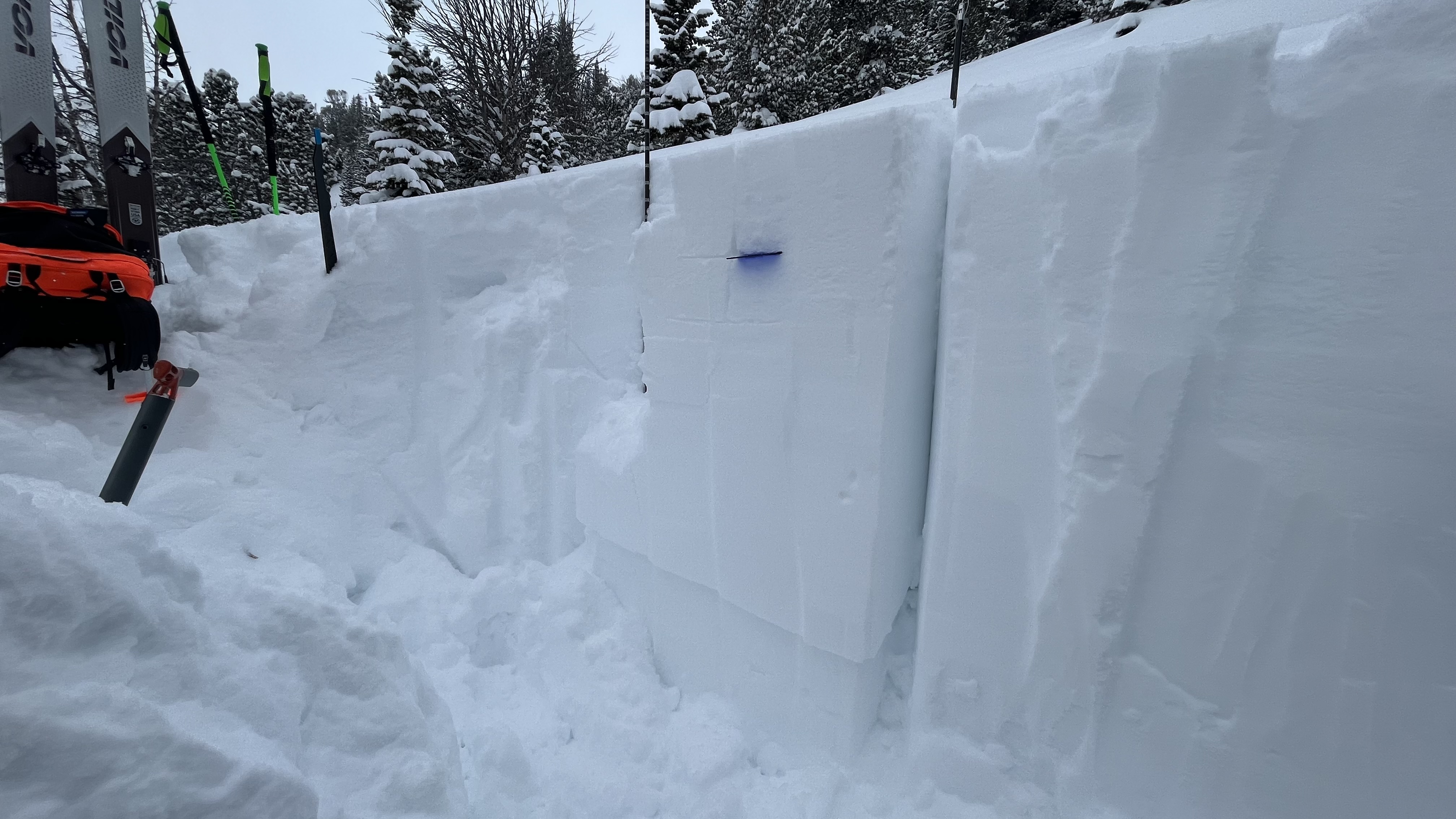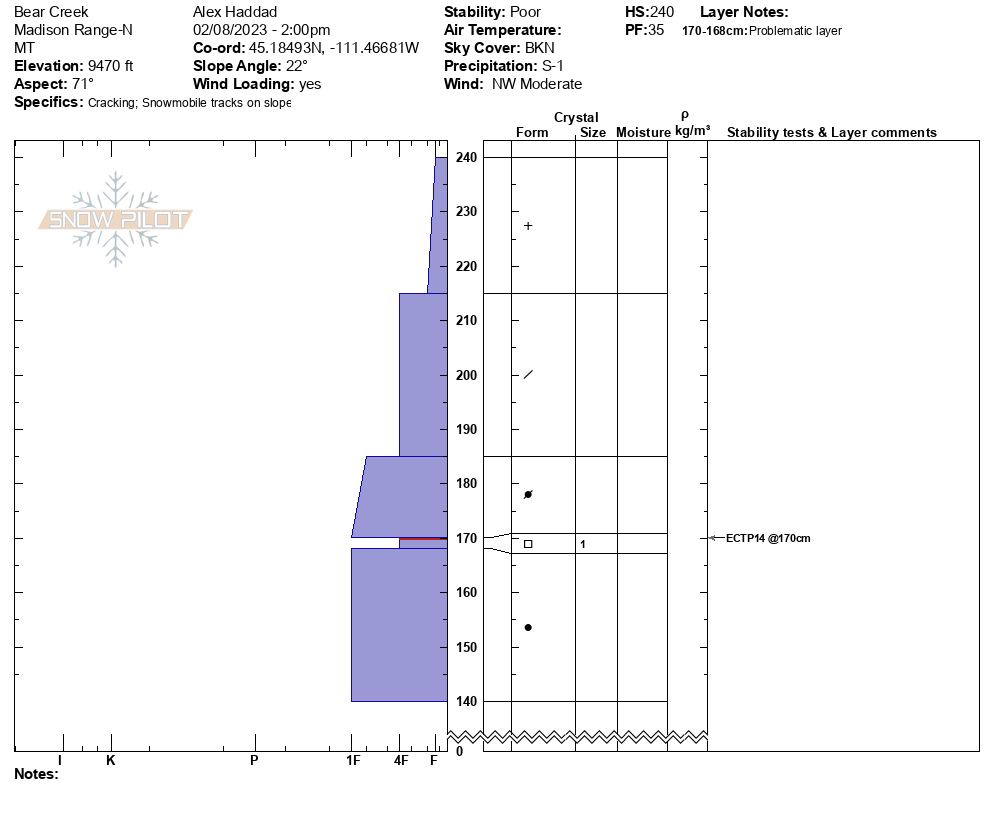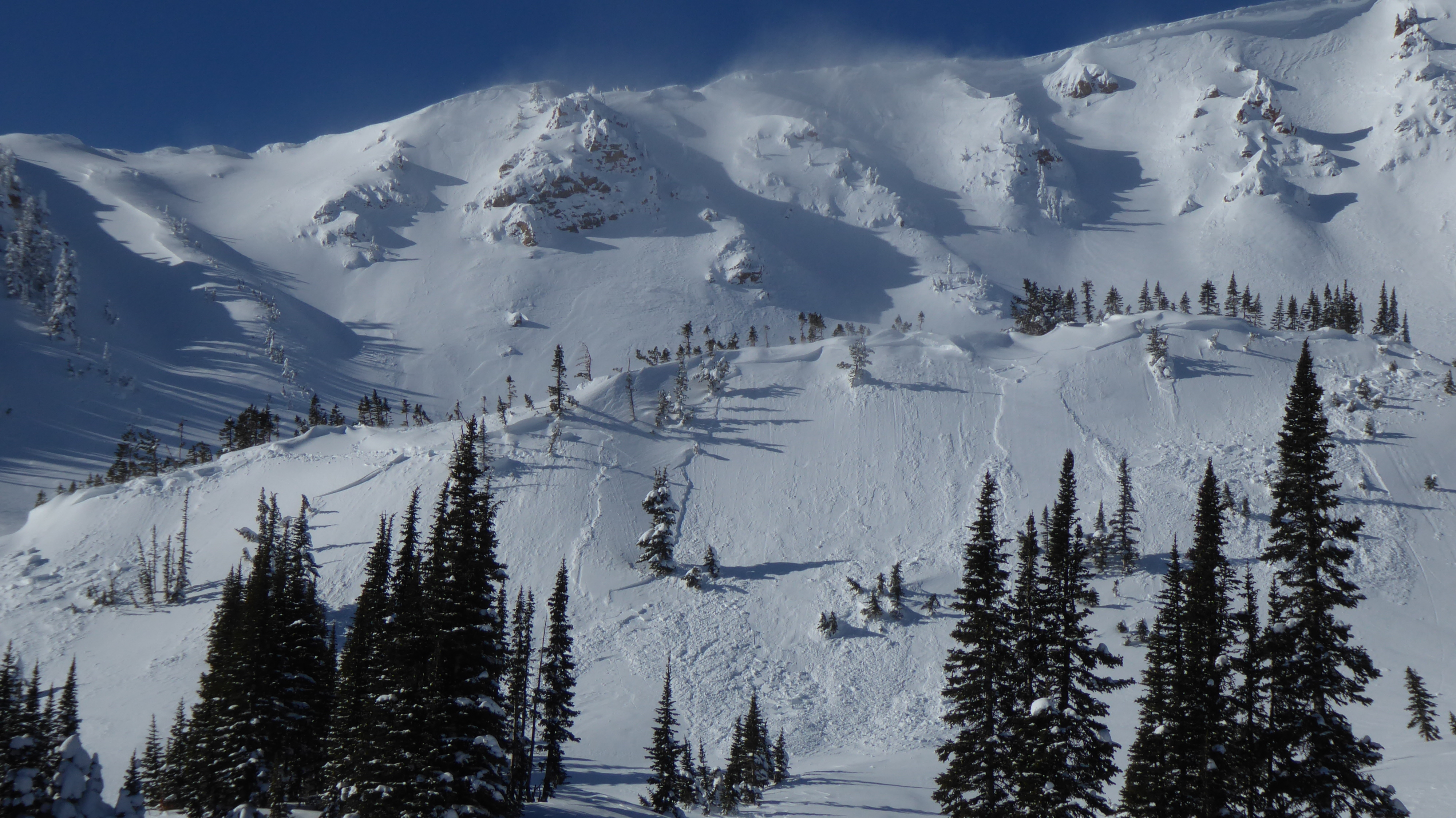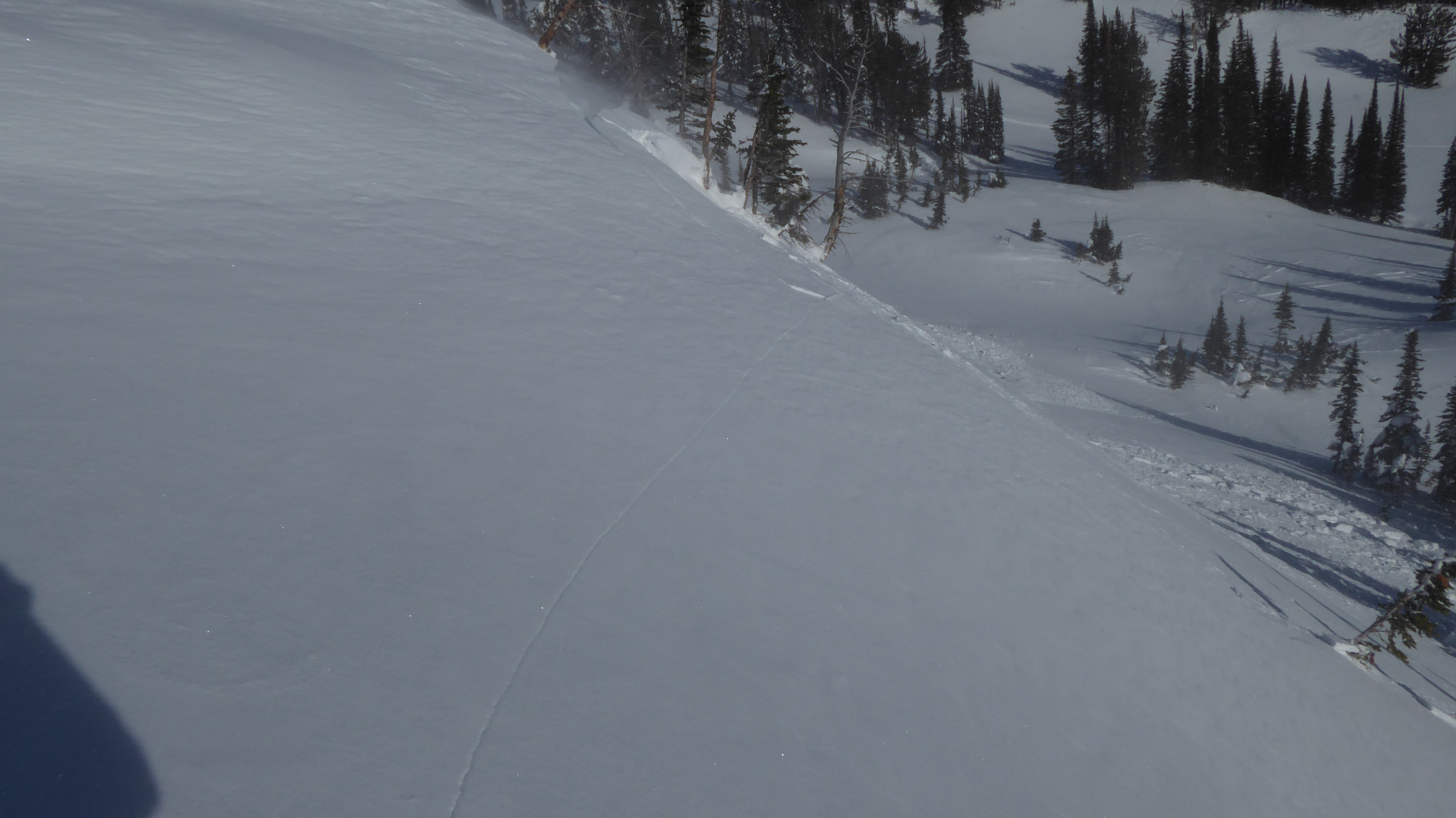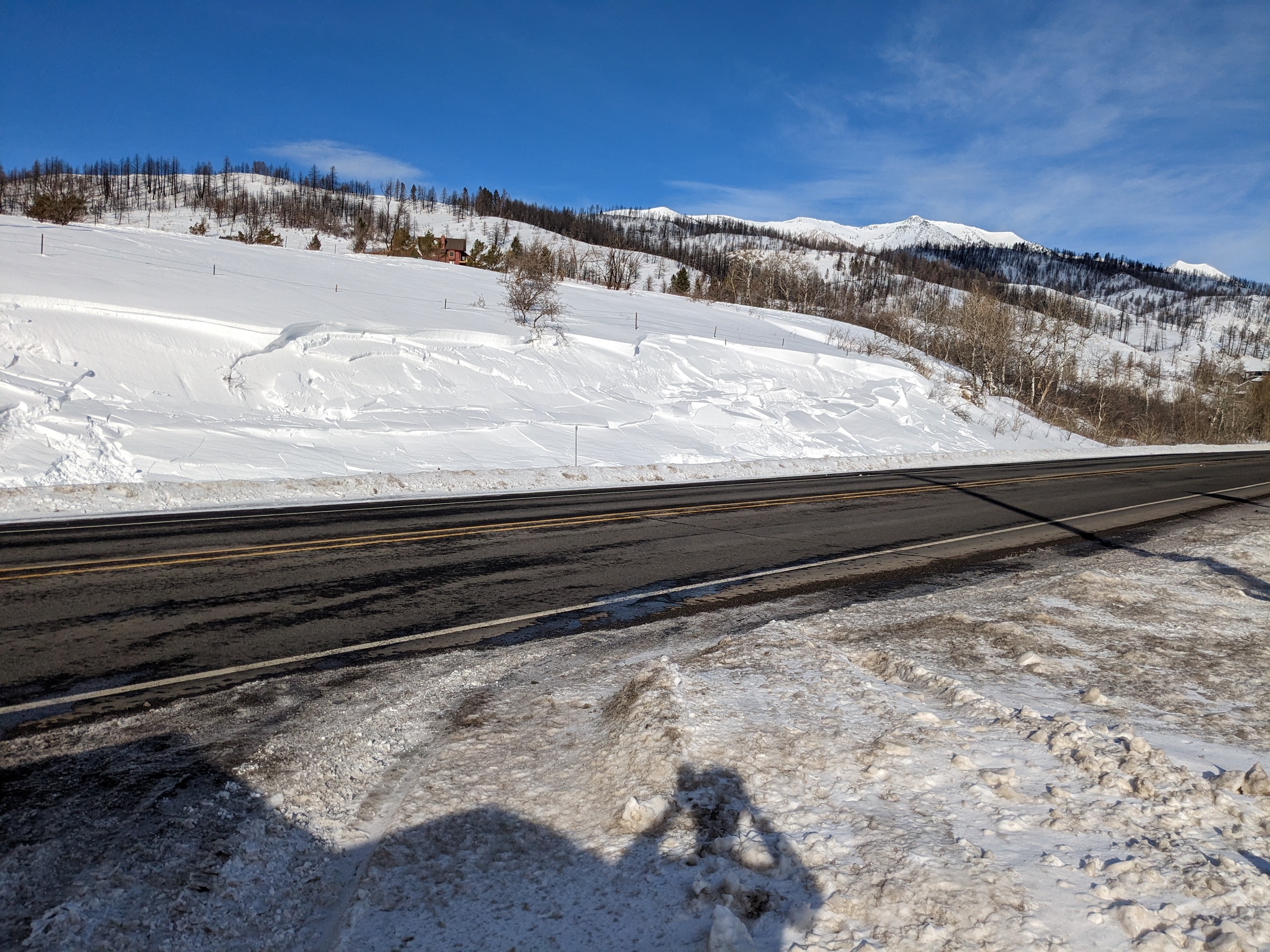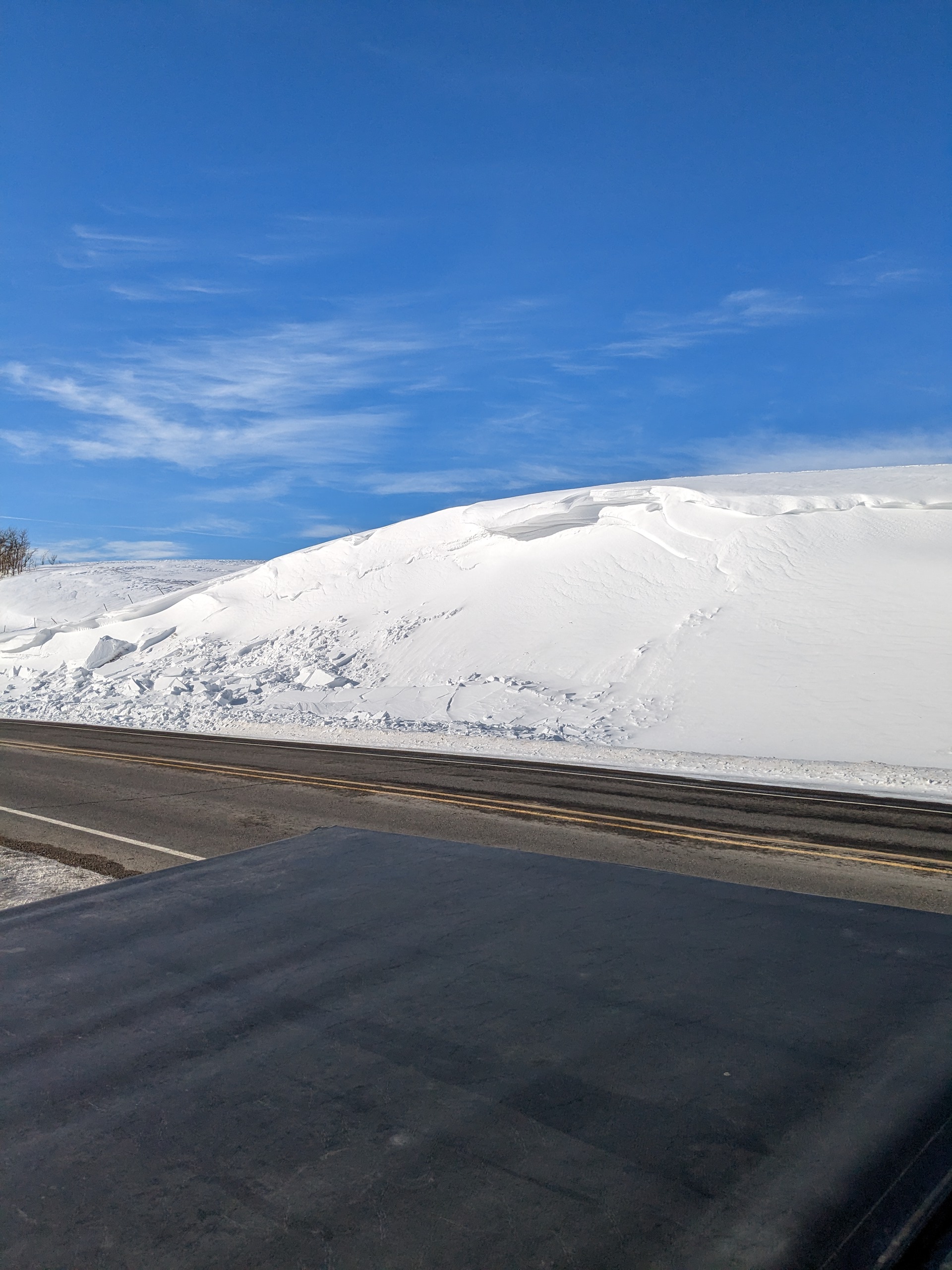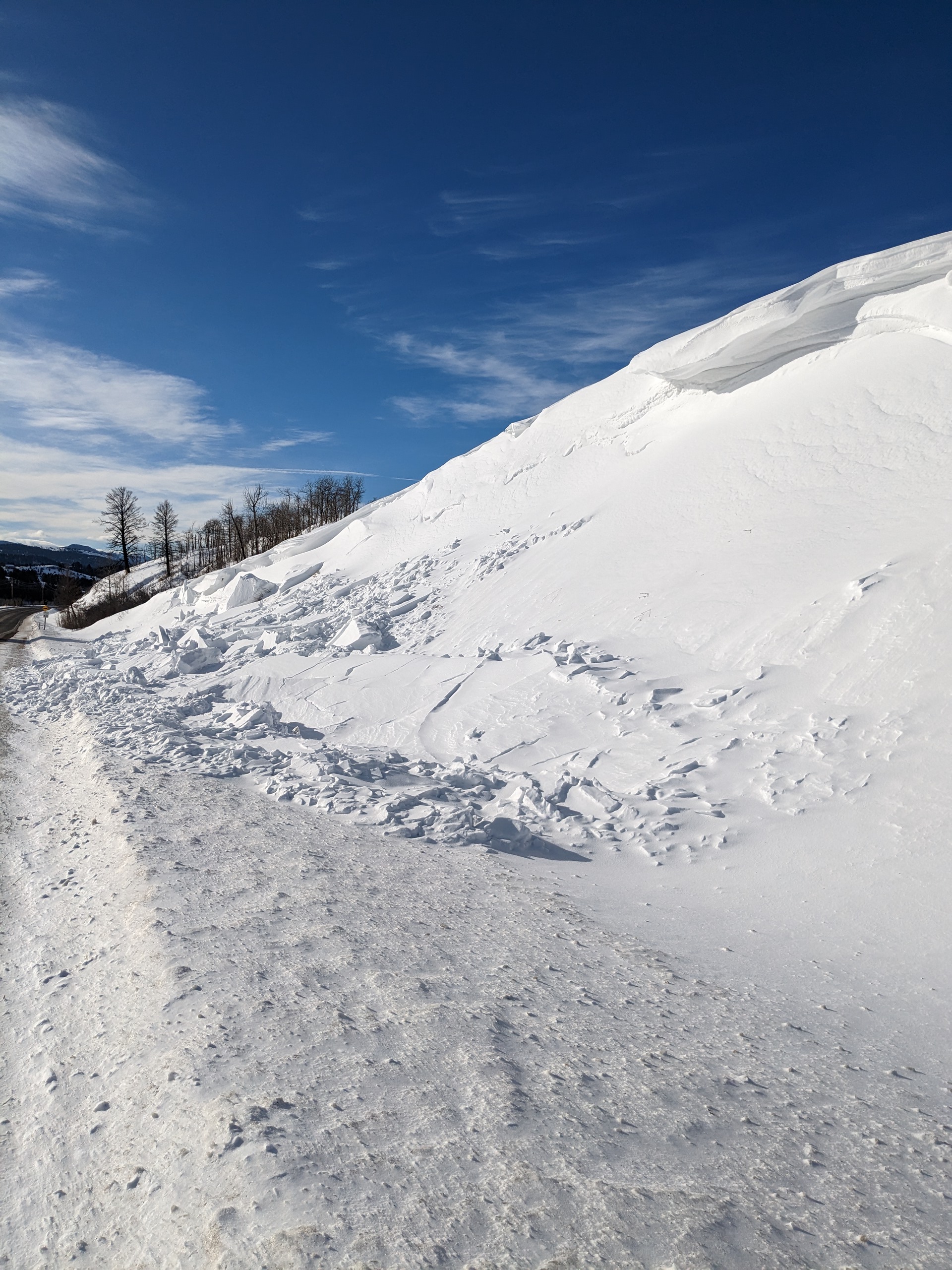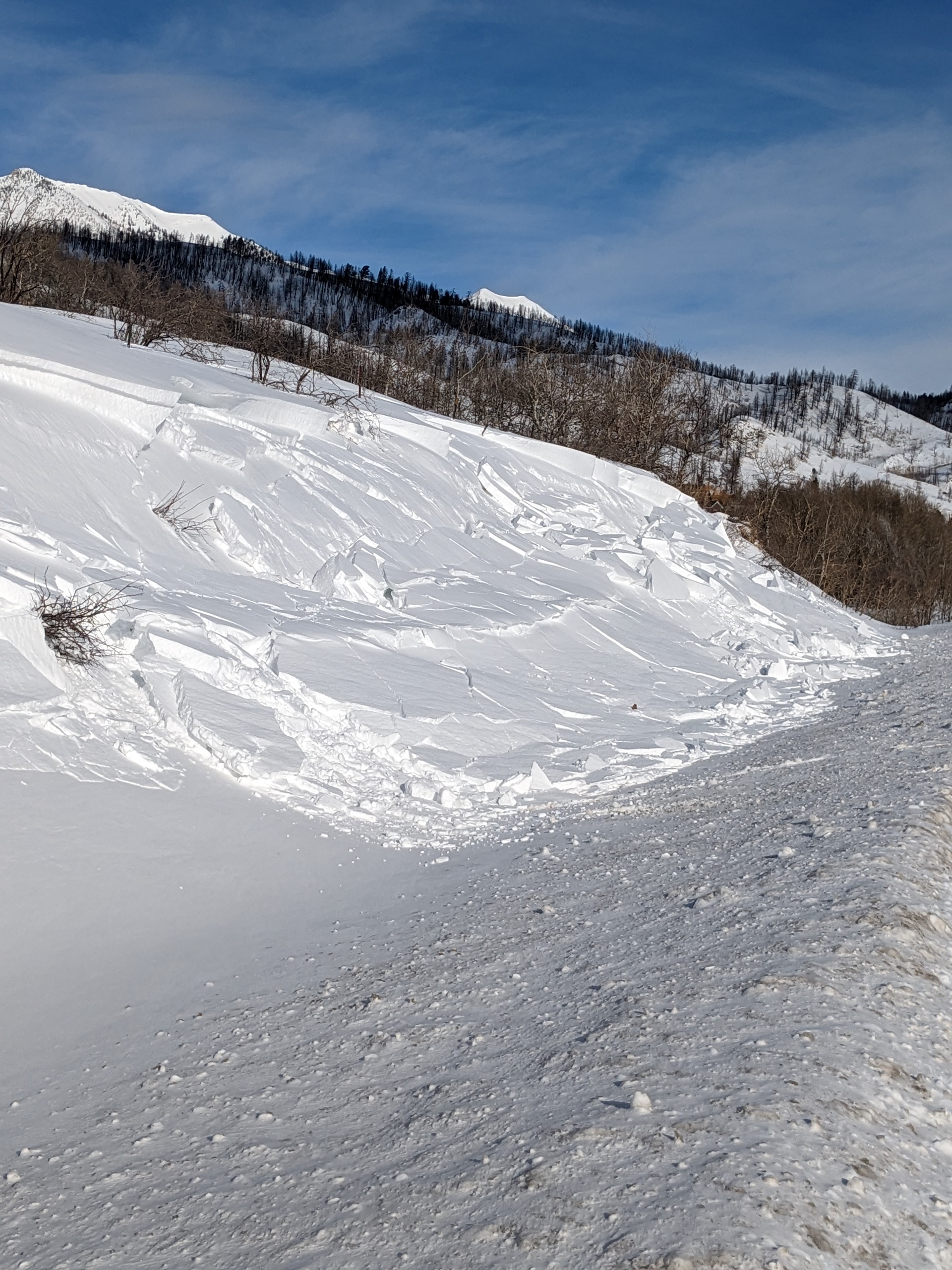Snow Observations List
We skied up the Throne and encountered serious wind effected terrain. Some slopes were blown clear, others has ripples of sastrugi, and yet others were wind-loaded. After a pit down low yielded nothing significant, we skied higher to look for wind-loaded slopes. We found a natural crack that occurred in a wind slab, and then we dug near the ridge at a spot we typically descend. We got an ECTP9, an unstable test result. The video shows it well. Wind loads are isolated, but they could avalanche. They are easy to find: they were the only smooth parts of the slope.
Full Snow Observation ReportSkied in the bowl to the south of Pika point on a north facing aspect.
ECTN28 on top of very large facets in the bottom ~30cm of snowpack, but no result on a CT conducted directly adjacent to the ECT.
I've included a snowpilot pit profile here. Took my best guess at grain type - it looked like the facets between 80cm and 30cm were beginning to round.
Later in the day noticed some small (D1, R1) wet loose slides on steeper south faces.
Full Snow Observation ReportYesterday we toured around Alex Lowe Peak. We conducted a quick stability test on a northern aspect at the base of the peak. The result was an ECTN 13 @15cm. After the test we gave the column a few more hits (~ECTN 33) and it broke 70cm. Although it took some effort the shear was very clean. We ascended up the East face of Alex Lowe and observed isolated fractures of the top layer, about 20cm in depth, while cutting the skin track (see photo). While descending the North face the top layer sluffed readily, especially in wind loaded pockets, but no propagation was noted. During our exit at around 4pm we noticed significant wet loose releases on southern aspects (see photo).
Full Snow Observation ReportWe rode up Denny Creek to Lionhead Ridge. After that, we rode back towards Watkins and Targhee creeks. We dug a pit on a north facing aspect at 9000’. We found 5.5’ (170 cm) of snow. We had an ECTN27 on a layer of rounding facets ~1 foot below the surface. We had this same result on an E facing aspect. We saw some old avalanche activity under Lionhead Ridge, but there were no signs of recent avalanches.
Full Snow Observation ReportOur group toured up into Blackmore today with the goal of skiing lines on the E and N faces. We dug a pit on a representative slope near the base of Blackmore. The pit had a depth ranging from 110 to 130 cm and showed large faceted crystals near the ground with faceted crystals present up to 60cm from the surface. We performed a shovel shear test and had a failure 60 cm from the surface, which identified our layer of interest. Our first ECT had scores of ECTN3 in the newer snow and a ECTP19 at the ground. I felt that the propagation at the ground may have been affected by some undercutting from the cord and I wanted to see if we would have propagation on the layer down 60 cm so we performed another ECT directly behind the first. This test scored ECTP29 at the layer down 60 cm, which was expected. We decided to take a slightly more conservative approach to our line choice for the remainder of the day based on these results.
Also of note, as we traversed a corniced ridge later in the day, two of our group members simultaneously came too close to the edge of a cornice and it broke away, but did not fall down the slope. Fortunately, everyone was alright, but it was a close call and we will definitely be more mindful next time. We believe the cornice was made more sensitive by the warm weather over the past few days.
Full Snow Observation ReportPoor test scores in our pit, but deep snow.
HS 190cm
ECTP 22, 190-155cm, Q1 shear (fist to 4F)
ECTP 27, 155-135cm, Q1 shear (4-1F)
Shear 135-115cm, Q1 (1F)
All on 1-2mm facets. Pretty nasty layer cake, we skied less than 30° after digging. Obvious wind effect on the steep bowl, no recent activity but hard wind slabs above 9500’ pretty much everywhere
Pit location: 9120ft, 44.94353, -111.1315
Full Snow Observation ReportPoor snowpack structure present everywhere with facets to the ground. Some big beautiful depth hoar in pockets around the new growth down lower. I dug multiple hasty pits on the way up yielding no propagation on my ECT's until I reached 8,800' where the leeward (NW) side of the ridge had previous wind loading. There was an old wind slab ~1f+ and 70cm thick sitting on a 4f 5cm thick layer of 1mm grains of faceted snow. It failed at ECTP24 with a clean shear. I did not dig deeper than this here. Winds were light with moderate gusts, few clouds. Solars were warming but no recent activity was observed. Beautiful day for shady low angle skiing. Pictured below are crystals from the weak layer on the ECTP24 down70 @8800 NW on 30° slope.
Full Snow Observation ReportWhile on a tour today up Wheeler gulch, we noticed a few old crowns that released before the most recent snow, hard to say if they were natural or not. We also observed a most likely remote triggered small wind slab (not our tracks next to it). Solar aspects were hot. Top of snowpack was relatively stable in our 4 foot pit, some collapse but no propagation (E aspect, 8400 feet).
Full Snow Observation ReportDid a full profile while out in Goose Creek today. Results indicated poor stability on a NE aspect about 7200 ft. The primary layer of concern was the buried surface hoar layer roughly 30 cm down in this location, took moderate strength (ECTP18) to get full propagation. Skiing conditions were good in the new snow from this weekend, you could subtly feel the MF crust from the time before the recent storm. We observed a small layer of surface hoar this morning, that will most likely be destroyed today from the intense sun on solar aspects.
Full Snow Observation ReportOur group did a big loop - Daisy- wolverine- goose - sheep -lulu. Saw minimal wind transport except on high points ( see photo). After looking all day saw an R1D2 slide (see 2nd photo) on a ENE slope above 10,000' south of Lulu pass, unknown trigger, though the whole area around the slide had cornice growth. We observed a lot of tracks highmarking into windloaded alpine slopes but saw no rider triggered avalanches.
Full Snow Observation ReportWe rode into the head of Cabin Creek from Taylor Fork and turned around behind Sage Peak, then headed to the northwest side of Carrot Basin at the wilderness boundary. We did not see any recent avalanches. We dug two pits. One at the wilderness boundary and one off the north facing ridge in Carrot Basin. At the wilderness boundary HS was 140cm and we had ECTN24 on surface hoar/facets buried 40 cm down. We also had an ECTP14 on facets near the ground, but this one seemed more like an outlier. In our pit at Carrot Basin HS was 155 cm and we had ECTX. Overall, stability seemed to be good. With minimal recent snow, and weak layers becoming stubborn, the likelihood of avalanches is trending towards unlikely.
Full Snow Observation ReportOn our 3rd lap on the North Side Burn in Sheep Creek, we traveled up the ridge to take a look at the steeper terrain to the west along the ridge. From our protected vantage point, we could see a recent wind slab that appeared to release naturally some in the past 24 hours. The crown was obscured, but I would code the avalanche as SS-N-R1-D1-S. The avalanche was approximately 3-6" deep, 25' wide, and ran for ~60'.
Full Snow Observation ReportThis afternoon my group of 4 was riding up out of Tepee Creek heading towards Cabin Creek and I set off this small slide on a northeast facing slope as I was coming down it. The slide broke about a foot deep on top of the packed layer of snow and was 150-200' wide at the crown. Thankfully it slid slowly, less than 100' and I was able to ride out of it.
Full Snow Observation ReportThere was 9” of new snow at higher elevations compared to 4” at the parking lot, and what was accurately reported at Shower Falls SNOTEL. We saw strong winds blowing huge plumes of snow off Maid of the Mist proper. Spindrift and wind-loading into gullies, near ridgelines and other slopes exposed to the wind was our primary concern. We dug two snowpits, one in the Basin low on a north facing slope and another on the south-facing shoulder. We got ECTNs in both. We found the 2-3" thick layer of facets and surface hoar on the south-facing pit buried 3' deep. They propagated failure with a few extra hits in our ECT. They weren't sensitive where we dug today, but I would not forget about them.
We avoided wind-loaded slopes entirely and would recommend digging down three to four feet to test the upper level of the snowpack before considering any steep slopes.
Full Snow Observation ReportThe 3-5” of new snow at Buck Ridge has blown into 1-1.5’ wind slab throughout the area. Cornices were built along the trail, and along ridgelines. The wind continued to transport snow today. We rode towards Beaver Creek to see if there was any avalanche activity–we saw a few small wind slabs. Next, we headed to the head of Bear Creek. The snow had built big pillows of wind drifted snow along the climb to the wilderness boundary. We observed some cracking on this slope when we stepped off our sleds. We stopped and dug a pit on the east facing slope at 9,400’. We found 7.5’ of snow (240 cm), and we had an ECTP 14, 2.5 feet below the surface of the snow on a layer of facets.
Full Snow Observation ReportFrom FB: Had some tourists in the shop trigger an avalanche on two top yesterday. Didn't get exactly where or much details. Steep tracked up slope they set off. Just a partial sled burial.
Full Snow Observation ReportWe toured up to the bacon rind ridge, descended a southwest aspect, and then headed over and up to the Ernie Miller Ridge.
In sheltered locations, there was approximately 15 cm of storm snow from Sunday into Monday.
On an east-southeast aspect off of Ernie Miller between approximately 9000-9700', we found widespread 20-25 cm thick 1F wind slab sitting on 1 mm facets. The slab was moderately resistant in hand shears and remained intact once isolated. It was not reactive to our jumping on small test slopes. We observed no cracking during our ascent and saw no signs of reactivity during our descent.
Above approximately 9700', the surface was largely scoured and there was a thin wind skin.
We observed similar facets below the storm snow on our ascent of a southwest aspect between 8000-8700' on the way back up to the bacon rind ridge.
Full Snow Observation ReportWe rode up Yale Creek and into Mt Jefferson Bowl. Walking to the edge we triggered an avalanche (intentional) on a slope that was getting wind-loaded. It broke up to 1.5 feet deep, 250 feet wide and 50 feet vertical. The new wind drifts were sensitive to triggering and the slabs propagated wide. Weak layers at the old snow surface may have helped us remotely trigger the slope. The two things to look out for in the Centennials are weak layer of sugary snow or feathery surface hoar in the upper 3 feet of the snowpack and slopes that are freshly wind-loaded.
Full Snow Observation ReportDug a quick test pit on Tuesday on an E aspect in Middle Basin. Found that persistent weak layer we’d been worried about, but got an ECTX when we tested it. We railed on it pretty hard afterwards and finally got it to break. When it did, it propagated cleanly all the way. Looked like it didn’t quite have enough load to fail yet but it’s still set up to and maybe this storm that just rolled through brought that load. We did also see evidence of an old avalanche on an E aspect in Beehive basin. Looked to be a couple of days old, probably from before Monday’s storm.
Full Snow Observation ReportOne maybe two distinct seemingly natural large natural slab avalanches on small slope directly next to bridger canyon drive. One on the lookers left was likely cornice triggered, but on the right it's unclear to me if it propagated or released naturally.
Full Snow Observation Report